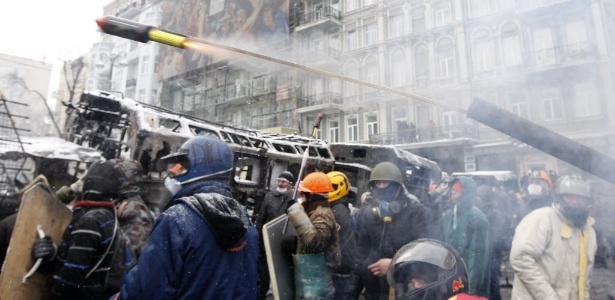Fonte: (
aqui)
Deaths of at least three demonstrators come as
businesses near protest hub reportedly ordered to close
Wednesday is Ukraine's
Day of National Unity, but the country has never felt so divided.At least three
people have died in Kiev, the first casualties of a protest movement
that has rumbled on for two months before bursting dramatically into violence
over the weekend.
Two protesters were shot dead during clashes with
police, who attempted to take back control of the city centre. Prosecutors
confirmed earlier claims by the protest leaders that the pair had been shot
with live ammunition. A third protester died after falling from a high column
at Dynamo Kiev's football stadium while fighting with police, Reuters reported.
Oleg Musiy, the coordinator of the medical service at
Independence Square, told a pro-opposition radio station that another two
people had been killed, though this could not be confirmed.
As President Viktor Yanukovych held long talks with the trio of opposition
leaders who have led the protests for the past two months, the deaths seemed
likely to further inflame the tense situation in the country.
Parts of central Kiev resembled a battle zone as thick
clouds of smoke filled the air and the sound of stun grenades rang out. Police
shot at demonstrators with rubber bullets, and rumours swirled that a storm of
the main protest encampment, the heavily barricaded Independence Square, could
begin at any time. At one point, police deployed an armoured personnel carrier
to back up their movements.

Martial law was effectively declared at 4pm local
time, as shops, hotels and other businesses in the area surrounding the hub of
the protests were reportedly ordered to close their doors for the day. A
full-on storm was not immediately forthcoming, however.
Riot police pulled back
from further clashes but were involved in a protracted standoff with protesters
near the Dynamo Kiev football stadium overnight. People brought thousands of
tyres to create a blazing wall in between the police lines and the protest
barricades. At midnight, a full-scale firework display was launched, with the
rockets aimed horizontally at police. On Independence Square, the already
formidable barricades were augmented with more sacks of snow, metal railings
and tyres.
The first attempts to
push back protesters came as dawn broke, amid a swirling blizzard. Police began
their assault on the impromptu barricades on Hrushevskogo Street, where clashes
have been ongoing since Sunday evening. Videos circulated of the police beating
and kicking protesters, many of whom were hurling rocks and molotov cocktails
at officers in scenes that shocked residents of Kiev. Political protest has
been a way of life here since the 2004 Orange Revolution, but before this week,
rallies have never descended into violence.
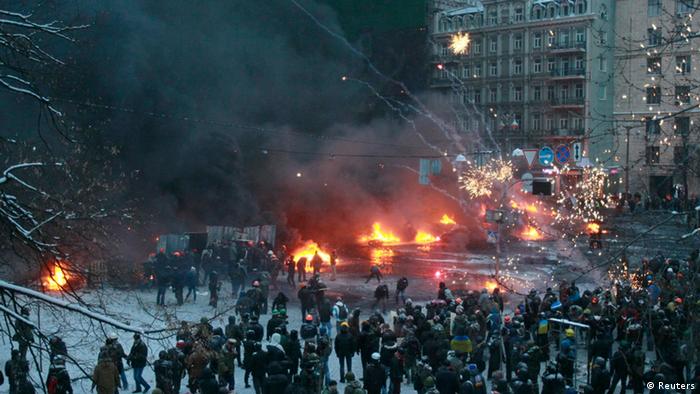
Police launched another
attack on protesters shortly after midday Kiev time (10am GMT), dispersing a
crowd of thousands of people, moving them hundreds of metres back. They used
teargas and rubber bullets and beat fleeing protesters with sticks. Some people
were arrested. Then thousands of policemen regrouped into new lines to take
shelter from stones being hurled at them.
Even as his riot police
were on the attack, Yanukovych released a statement urging them to
"regulate the conflict in a peaceful way" and saying he was against
"bloodshed and forceful methods". He asked the opposition to hold
talks and demanded that people "not heed the calls of political radicals".
Vitali Klitschko, the
opposition leader and former heavyweight boxer, called on Yanukovych to
announce snap elections as a way to resolve an ongoing political crisis.
"I know that this
very second he [the president] is watching this live broadcast. You, the
president, you know that snap elections will change the situation without
blood, and we'll do everything to achieve this," Klitschko told the crowd
in Independence Square on Wednesday evening. He added that talks with
Yanukovych that started on Wednesday would have to continue on Thursday,
otherwise "we will go on the attack".
Yanukovych on Wednesday
met the three main opposition leaders – Klitschko, nationalist Oleh Tyahnybok,
and Arseniy Yatsenyuk, of jailed former prime minister Yulia Tymoshenko's party
– for three hours.
The prime minister,
Mykola Azarov, struck a defiant note, blaming the victims for their own deaths
and saying that the government had "no other option" but to use force
against protesters.
"The participants
of these disturbances cannot be called peaceful. These are criminals, who are
disturbing order. I want to officially state that the victims are the
responsibility of the troublemakers."
Azarov said terrorists
were threatening the lives of ordinary citizens in Kiev, and that the
"criminal" actions of protesters would be punished and suggested
further force was possible. He was due to appear at the World Economic Forum in
Davos later on Wednesday, but his invitation was reportedly withdrawn.

Earlier the protesters
reconstructed their barricades as thousands came to support them.
In a letter read out by
her daughter Eugenia in Independence Square, Yulia Tymoshenko called on the
protesters to continue their struggle. "The blood of these heroes of
Ukraine lies on the hands of Yanukovych," the letter said. "If we,
Ukrainians, forgive him this, then we will deserve everything he will do to us
later."
Vasyl, 76, a pensioner
from the central Cherkasy region, said: "They [the authorities] provoked
this. We are unarmed but nevertheless they are afraid of us." His friend
Pavlo, 60, wearing stripes in the colours of Ukrainian and EU flags, said he
came to support the protesters and was ready to throw stones at police.
"The blood is the
fault of the convict [Yanukovych] and his party. We want these occupiers to
leave Ukraine."
An exhausted Orthodox
priest with a huge cross around his neck trudged between the lines, trying
unsuccessful to bring calm. "I'm here to placate the violence. My
congregation is here," he said.
Yuriy Lutsenko, a
Ukrainian former interior affairs minister, called on riot police to stop
fighting against the protesters. "Soldiers, if you stand here we will
become Russia and you will have to go and fight in Chechnya," he said
through a loudspeaker, addressing lines of police from a minivan in the middle
of the crowd. "This is not your war. This is a war of the Ukrainian people
against the mafia."
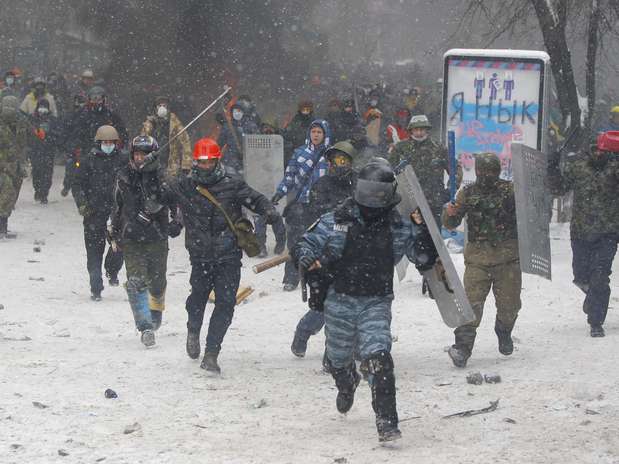
The protests began when
Yanukovych turned his back on a planned association agreement with the European
Union, citing financial pressure and the need for closer ties with Russia. They
have since grown into a more general protest against Yanukovych's government,
and have also attracted a noisy minority who hold radical far-right views.
Condemnation of the
violence came in a torrent from across Europe. Carl Bildt, the Swedish foreign
minister, described the situation as extremely serious. The EU's response
remains to be seen, he said, but "it won't be business as usual".
José Manuel Barroso, president of the European commission, said he was shocked
at the deaths. He added: "I would like to explicitly underline the
fundamental responsibility of the Ukrainian authorities to now take action to
de-escalate this crisis and, in particular, the need for them to engage in a
genuine dialogue with the opposition and with civil society on the ways to
overcome this deep crisis."
The United States
revoked visas to several Ukrainian officials on Wednesday over the violence in
November and December of last year.

The main voice of
support for tough action has come from Moscow, where on Tuesday, foreign
minister Sergei Lavrov accused European politicians of "fuelling" the
violence in Ukraine, and noted that in any European country, the seizure of
public buildings and violence against police would also be met with force.
Osvaldo Aires Bade Comentários
Bem Roubados na "Socialização" - Estou entre os 80 milhões Me Adicione
no Facebook
UKRAINE'S VITALI KLITSCHKO: 'THIS IS A BATTLE AND I DON'T PLAN TO GIVE UP EASILY'
As
Ukraine's street protests against corruption grow increasingly ugly, the
unlikely figure of heavyweight boxer Vitali Klitschko has emerged as a voice
for the opposition. What will happen next – and why has he taken on the biggest
fight of his life?
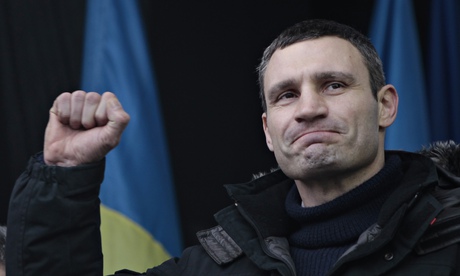 Klitschko in Kiev … 'We need to join all our forces.' Photograph: AP
Klitschko in Kiev … 'We need to join all our forces.' Photograph: AP
People have been trying to land kicks and punches on Vitali Klitschko for most of the past two decades, and he has
brushed almost all of them off with ease. But his current opponent, Ukrainian
president Viktor Yanukovych, has a few advantages that none of the previous
challengers possessed: several
thousand riot police at his disposal, for a start, and the use of a pliant court system to
prevent Klitschko from entering the ring in the first place.
Klitschko, whose PhD in sports science combined with a
fearsome reputation as a former heavyweight champion earned the 42-year-old the
nickname "Dr Ironfist", has emerged as the natural leader of the street protests
that have swept Ukraine for the past two months, ever since the president went back on his promise to
sign an association agreement with the EU. Crowds, mainly from the pro-European
west of the country, were initially drawn to stand up for their desires of
European integration, but the rallies soon morphed into general discontent with
the bloated kleptocracy that critics say surrounds the president. Barricades
were erected around Independence Square, and every day for two months, politicians
including Klitschko have addressed crowds from the stage, rallying the masses
in protest against the president he eventually hopes to succeed.
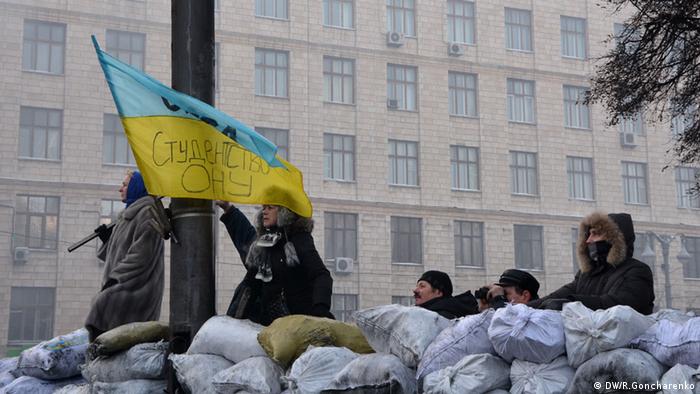
Klitschko has
his hands full trying to contain the protest movement which erupted into violence
on Sunday night,
as thousands hurled rocks at riot police and set their buses on fire. Klitschko
was moving through the crowds, unsuccessfully calling for calm, and at one
point was even sprayed in the face with a fire extinguisher by an angry
protester.
But despite the difficulty and complexity of the task
ahead, Klitschko is resolutely confident that the protests, which have so far
failed to draw any major concessions from Yanukovych, represent a victory for
the Ukrainian people.
"People are saying: 'We don't want to live like
this. We want things to change,' he tells me just days before the mood turned
violent. "This is a victory in the head of every Ukrainian, and in their
heart – and this is worth an awful lot."
Dressed in a dark grey suit that sits surprisingly
elegantly on his enormous frame, Klitschko speaks slowly and methodically.
"The system today is built to service the clan,
the family, and not society as a whole. Yanukovych doesn't want change. He says
he does. But he says he wanted European integration and that turned out to be a
con."
He pauses, blinking, before answering each question,
usually with carefully formulated and somewhat monotonous answers. Would he put
Yanukovych on trial for the corruption that has escalated under the current
regime, and the blatant enrichment of his family members? Klitschko pauses.
"If people break the law, they should be punished," he says. So is
that a yes? What does he personally think about Yanukovych? He pauses again.
"If people break the law, they should be punished." It is as though
he has discovered the concept of speaking like a politician, but not yet
mastered the craft.
He might lack the fiery charisma of born political
leaders, but in a country where the 2004 Orange Revolution was
followed by huge disappointment, and people are all too used to broken promises from
politicians, Klitschko's plodding sincerity and political neophytism are
attractive qualities. Unlike many Ukrainian politicians, he is free from
allegations of corruption. The expensive watch on his wrist and the smart cars
he drives can be accounted for by the millions that he earned in transparent
fashion in the boxing ring.
Klitschko's boxing statistics are extraordinary. He
won 45 of 47 professional fights, and was never knocked out once. Boxing
aficionados suggest that the time of his dominance was not a particularly
glorious era for the sport and that he never faced a truly brilliant
challenger, making him a boxing equivalent of Pete Sampras – repeatedly
victorious yet not destined to be remembered as one of the all-time greats.
Nevertheless, along with his younger brother, Vladimir, he has completely
dominated the sport for a decade.
Klitschko's father was a Soviet military pilot, and
the young Vitali grew up on military bases across the former Soviet Union,
moving from the Central Asian steppes to the Baltic before settling in Kiev in
1984 as a teenager. With its chiselled features and sombre expression,
Klitschko's face could come from a Stalin-era poster extolling the Soviet
sporting hero,and his aura of moral grounding and sincerity certainly came
across during his boxing career. He cut an unusually polite figure in a milieu
normally associated with hubris and puerile bravado.
Klitschko recalls a fight
against Briton Richard Vince, in Norwich, back in 1994. It was before he had
become boxing world champion and was instead tearing up the kickboxing circuit,
and he travelled to Britain for a world title fight in the sport.
"The whole family of my opponent came to the
fight and were sitting in the front row. His dad, mum, wife and kids were
there. I knocked him out in the second round and he blacked out. He was lying
there unconscious, and I saw pain in the eyes of his family. After that I said
that my relatives should never come to my fights. I don't want to cause those
emotions in my family." He also says he sought out Vince's relatives and
apologised to them after the fight. When his brother Vladimir, five years his
junior, also became a successful heavyweight boxer, he promised his mother that
the pair would never fight each other.
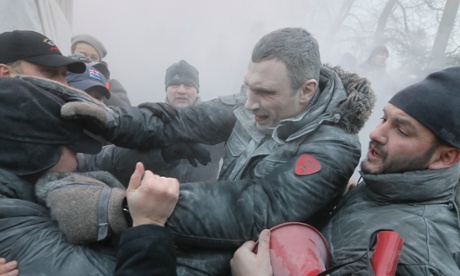 Klitschko, center, is attacked and sprayed with a fire extinguisher as he tries to stop clashes. Photograph: Efrem Lukatsky/AP
Klitschko, center, is attacked and sprayed with a fire extinguisher as he tries to stop clashes. Photograph: Efrem Lukatsky/AP
I try my hardest to steer clear of hackneyed
comparisons between the boxing ring and the Ukrainian political fight, but
Klitschko himself repeatedly wheels out the metaphors. Even the name of his
political party, the Ukrainian Democratic Alliance for Reform, handily
condenses into the acronym Udar, the Russian and Ukrainian word for
"punch".
"In order to land a punch, you need to bring your
fingers together into a fist. We need to join all of our forces together. That
is the only way that we can win."
Klitschko and Tyahnybok have been joined on the stage
by Arseniy Yatsenyuk, the representative of jailed former prime minister Yulia Tymoshenko's Fatherland party.
"Three things unite us," says Klitschko of
the troika of opposition leaders. "The first is disagreement with the
current economic situation; the second is that we see European integration as
the only future for Ukraine,
and the third is the struggle against the current authoritarian regime."
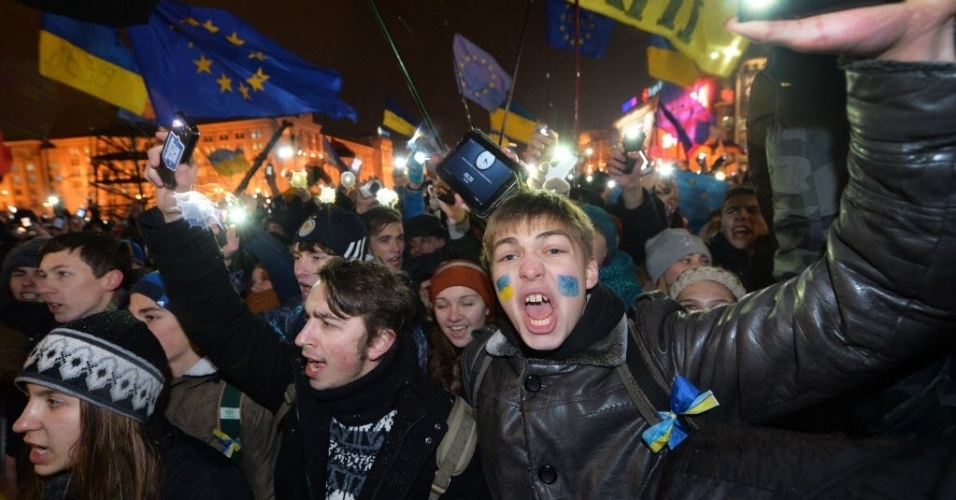
Tymoshenko, who was one of the leaders of the Orange
Revolution, was considered Yanukovych's most dangerous potential enemy before
the emergence of Klitschko, and most people believe her jailing was a political
decision. However, Yatsenyuk lacks the charisma of his party leader, and with
his spectacles and roll-neck jumpers looks more like a linguistics professor
than a rousing political leader.
With Tyahnybok's appeal limited to the more
nationalist west of Ukraine, most people assume that if the opposition puts
forward a united candidate to take on Yanukovych in presidential elections,
Klitschko is the only viable choice to appeal to a broad demographic. The vote
is scheduled for 2015, though one of the key demands of the protests from the
start has been early elections.
The government has attempted to bar him from any
future presidential race by introducing a new law that would disqualify him due
to his extended absences from the country while he pursued his boxing career.
He was resident in Germany for a long period, and recent rumours in the
Ukrainian press say he also has a US social security number and pays US taxes.
The boxer, who suddenly starts referring to himself in the third person, says
the new electoral law is a nonsense.
"The idea is deliberately being fed to society
that Klitschko can't stand. I have always been a citizen of Ukraine since the
moment of our independence. I was registered in Ukraine and I live in Ukraine.
But sport is global, and everyone knows that you can't limit yourself to one
country. The authorities are doing everything to ensure Klitschko can't stand
in elections. But I will say it once again: there are no reasons to remove me
from the elections."
When I ask what he will do if he, nevertheless, is
banned from standing, he is evasive, saying he will "defend his position
firmly". What does this mean? "My position is clear to everyone … and
I am certain that they won't do something so stupid. It would be the same as
saying that ice is warm or water is dry." Yanukovych's government has made
its fair share of decisions that many might regard as stupid over recent
months, I point out.
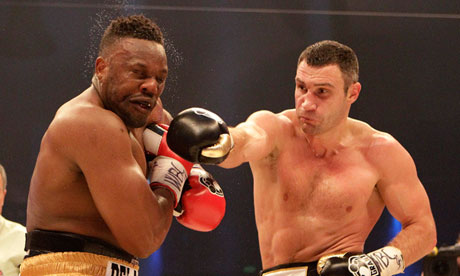 Klitschko, right, lands a punch on Britain's Dereck Chisora during a title bout in 2012. Photograph: Frank Augstein/AP
Klitschko, right, lands a punch on Britain's Dereck Chisora during a title bout in 2012. Photograph: Frank Augstein/AP
"Then I will fight it. This is a battle, and I
don't plan to give up easily."
The question of just how far he is willing to go in
terms of violent opposition to a regime that has refused to listen to peaceful
protest remains unanswered, but he is insistent that any violence is the fault
of the authorities.
"The protest mood in Ukraine is at a higher
temperature than ever before," says Klitschko towards the end of the
interview. "We only need a small spark for the situation to develop in a
way that will be completely out of control for the authorities."
His words turn out to be prophetic, as the rally on
Sunday turned violent,
with dozens of protesters and police injured, and the way out of the political
impasse is now even more unclear. Klitschko will need to negotiate the
landscape and make a decision on whether he goes for all-out war with the
regime, or bides his time until a 2015 vote. He went to see Yanukovych on
Sunday evening, where the president offered to start negotiations with the
opposition leaders. However, on Monday, it was announced that Yanukovych
himself would not attend the talks.
"Not signing the EU integration agreement, attacking
peaceful protesters and ignoring human rights – all of these were indicators of
the way things are in Ukraine right now. If these things keep happening, then
nobody can predict how it will end."
Klitschko warned Yanukovych on Sunday night to
"find strength and not repeat the fate of Ceausescu and Gaddafi",
referring to the former Romanian and Libyan dictators who ended up dead. He
added that if the government did not pull back from violence then "civil
war cannot be ruled out". While the majority of protesters remain
peaceful, it is clear that the radical element is growing, partly in reaction
to new anti-protest laws which essentially make the street rallies that have
paralysed the capital illegal.
Klitschko announced
recently that he was retiring from boxing to concentrate on his political
career. He has been given "champion emeritus" status, which would
allow him to mount a challenge to any new champion at any time, but he says
that such thoughts are far from his mind at the moment.
"I am thankful for
this title of champion emeritus, and proud I never lost my title. A lot of
people want to see a last fight, but I am now engaged in a different fight. One
that is much harder, much more vicious and much more important to me. I am
fighting for democracy, and fighting for Ukraine."
Kiev protests intensify on Ukraine's Day of National Unity - video
Clashes between anti-government protesters and police have intensified on Wednesday following the death of two protesters overnight. Wednesday is Ukraine's Day of National Unity, although the socio-political climate is anything but united. Martial law has effectively been declared, with parts of the capital resembling a battle zone. Protests began two months ago when President Yanukovych snubbed an agreement with the European Union in favour of closer ties with Russia
Ukraine's opposition leaders address protesters after rejecting Yanukovych's compromise - video
Leaders of Ukraine's main opposition party address a crowd of anti-government protesters on Saturday in Kiev's independence square, also known as Maidan Nezalezhnosti. The main opposition party, Batkivshchyna or the All-Ukrainian Union 'Fatherland', has rejected President Viktor Yanukovych's offer of the roles of prime minister and deputy prime minister for its leaders. Shortly after the protest rally, crowds descended on the international convention centre, Ukraine house, hurling items through windows and letting off fireworks inside.
Osvaldo Aires Bade Comentários Bem Roubados na "Socialização" - Estou entre os 80 milhões Me Adicione no Facebook
1º - UCRÂNIA: VEJAM NO QUE SE ESTÃO A METER (aqui)
 La Braña 1, nome usado para batizar indivíduo de 7 mil anos que viveu no período Mesolítico, que tinha olhos azuis e pele escura (Foto: PELOPANTON / CSIC)
La Braña 1, nome usado para batizar indivíduo de 7 mil anos que viveu no período Mesolítico, que tinha olhos azuis e pele escura (Foto: PELOPANTON / CSIC)